various vacuum pumps introduction
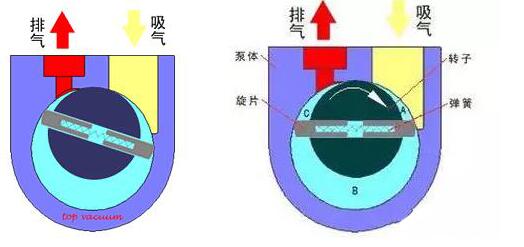
rotary vane vacuum pump working principle:
The rotary vane of rotary vane vacuum pump divides the crescent space enclosed by the rotor, pump chamber and two end caps into three parts: A, B and C. When the rotor rotates in the direction of arrow, the volume of space A connected with the suction port increases gradually and is in the process of suction. The volume of space C connected with the exhaust port is gradually reduced and is in the process of exhaust. The volume of space B in the middle is also gradually decreasing and is in the process of compression.
Because the volume of space A increases gradually (i.e. expands), the pressure of gas decreases, and the pressure of gas outside the inlet of the pump is stronger than that inside space A, the gas is inhaled. When space A is isolated from the suction port, that is to say, when it moves to space B, the gas begins to be compressed, the volume gradually reduces, and finally communicates with the exhaust port. When the compressed gas exceeds the exhaust pressure, the exhaust valve is pushed open by the compressed gas, and the gas is discharged into the atmosphere through the oil layer in the tank. Continuous operation of the pump achieves the purpose of continuous pumping. If the exhausted gas passes through the airway and transfers to another stage (low vacuum stage), it is pumped out by the low vacuum stage, and then compressed by the low vacuum stage and discharged into the atmosphere, a two-stage pump is formed. At this time, the total compression ratio is borne by two stages, thus increasing the ultimate vacuum.
rotary vane vacuum pump characteristics and application scope :
rotary vane vacuum pump characteristic:
The suction port of the vacuum pump is equipped with a coarse filter with wire mesh. It can prevent solid particles from being sucked into the pump chamber. The oil separator is equipped with an exhaust transitor with high efficiency for oil and gas separation. When the pump stops, the suction valve built in the suction port isolates the pump from the pumped system and prevents oil from returning to the pumped system. The pump is cooled by air. All pumps of XD rotary vane vacuum pump are driven by direct motor through elastic coupling.
rotary vane vacuum pump scope of application:
1.Vacuum pumps are suitable for vacuum pumping in closed systems. Such as vacuum packaging, vacuum forming, vacuum attraction.
2.Inlet pressure range: 100Pa-100000Pa. Oil mist will be generated at the outlet of the vacuum pump working beyond this range. The working environment temperature and the inhalation gas temperature of XD rotary vane vacuum pump should be between 5 ~40 C.
3.Vacuum pumps cannot pump water or other liquids. No explosive, flammable, excessive oxygen and corrosive gases can be removed.
4.Generally supplied motors are not explosion-proof. If explosion-proof or other special requirements are required, the motor must meet the relevant standards.
rotary vane vacuum pump application :
Its working pressure range is 101325-1.33 *10-2 (Pa), which belongs to low vacuum pump. It can be used alone or as the front pump of other high vacuum pumps or ultra-high vacuum pumps. It has been widely used in metallurgy, machinery, military industry, electronics, chemical industry, light industry, petroleum, medicine and other production and scientific research departments. Rotary vane vacuum pump is one of the basic equipment for gas extraction. It can be used alone or connected with super high pumps such as booster pump, diffusion pump, molecular pump and so on.
1.Rotary vane vacuum pump is the basic equipment used to extract gases from specific sealed containers so that the container can obtain a certain vacuum. Due to the high development of modern science and technology, the application of rotary vane vacuum pump extends to various scientific fields and various enterprises and institutions. It can be used for metallurgy, chemical industry, light industry, petroleum, medical treatment, pharmacy, printing and dyeing, electrical appliances, vacuum, semiconductor, food, food, etc. Scientific research institutions such as atomic energy, textiles, colleges and universities, industrial and mining enterprises are used for scientific research, production and teaching. It is widely used in oil press.
2.Rotary vane vacuum pump is made of ferrous metal, and it is more precise. The work of the whole pump is linked together, so the rotary vane vacuum pump is not suitable for pumping out all kinds of gases which contain too much oxygen, poisonous, explosive erosion of ferrous metal and have chemical effect on vacuum oil, nor can it be used as compressor and conveying pump. If there is a pump with an air-ballast device, a certain amount of condensable vapor can be removed.
Rotary vane vacuum pump performance characteristics:
Rotary vane vacuum pump is a vacuum pump with periodic volume change of pump chamber separated by rotating vane to realize pumping. When working fluid is used to lubricate and fill the dead gap of pump chamber and separate exhaust valve and atmosphere, it is commonly called rotary vane vacuum pump of Schindler vacuum pump. Its performance has the following characteristics:
1.Small size, light weight and low noise;
2.An air ballast valve is provided to remove a small amount of water vapor.
3.High vacuum limit;
4.Compulsory oil feeding, full lubrication, reliable performance;
5.Double safety device for automatic oil return prevention is installed.
6.Continuous operation can be maintained at the intake pressure of 1.33 *10 Pa.
7.No oil leakage, no oil injection and no pollution to the working environment. The exhaust device has a special oil mist collector.
8.It can be equipped with small caliber transfer joint and international standard KF interface.
rotary vane vacuum pump application characteristics:
Pumping rate: 4-100L/S (liter/second)
Limit pressure: <6*10-2Pa(Pa)
Limit Vacuum: <1.3Pa (Pa)
Gas type: Clean and dry air without other mixtures at room temperature. No air containing other dust and moisture is allowed.
Requirements: When the inlet pressure is greater than 6500 Pa, continuous working time should not exceed 3 minutes to avoid pump damage caused by fuel injection.
Working requirements: The import pressure is less than 1330 pa, allowing long-term continuous work.
Ambient temperature: Vacuum pumps are generally used at room temperature of not less than 5 C and relative temperature of not more than 90%.
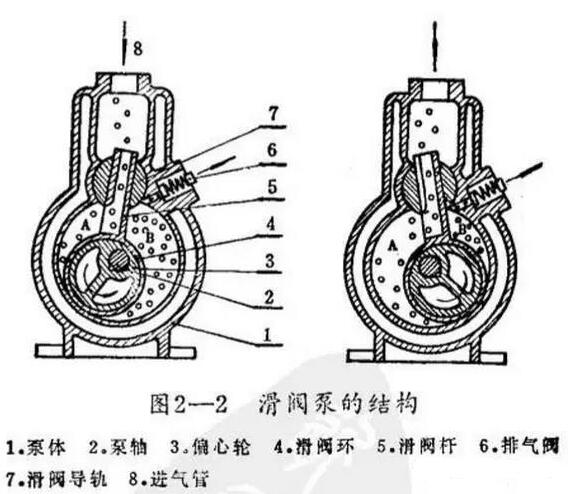
Piston Vacuum Pump working Principle:
Piston vacuum pump, like rotary vane pump, is also a variable volume gas transmission pump. Its scope and operating conditions are basically the same as those of rotary vane pumps.
This kind of pump can also be divided into single-stage pump and double-stage pump, with vertical and horizontal structure.
The pump is mainly composed of the pump body and the slide valve which rotates eccentrically in the cylinder. The pump cylinder is equipped with a slide valve ring (4) and an eccentric wheel (3). The eccentric wheel is fixed on the shaft (2), and the shaft coincides with the center line of the pump cylinder. The slide valve ring is equipped with a rectangular slide stem (5), which can slide up and down and swing left and right in the semi-circular slide valve guide rail (7). Therefore, the pump cylinder is divided into two chambers A and B by the slide valve ring and the slide valve stem. During the operation of the pump, the volume of the two chambers A and B changes periodically (between minimal and maximum), so as to achieve the purpose of air pumping. The double-stage sliding valve pump is actually connected by two single-stage pumps in series. Its high and low vacuum chambers are in the same pump body. Some of them are directly cast into a whole, and some are pressed into the middle partition to divide the pump chamber into high and low chambers. However, the two chambers are not directly connected with each other. Instead, the high vacuum chamber sucks the gas in the container into the upper cavity of the pump chamber after expansion and compression, and then sucks the gas from the low vacuum chamber and discharges it out of the pump through expansion and compression process.
Piston vacuum pump is often used in large-scale vacuum equipment because of its structural characteristics and much larger capacity than rotary vane pump. There are two types of piston vacuum pump: single stage and double stage. The limit pressure of single-stage pump is less than 0.6Pa for small pump, 1.3Pa for large pump and 0.06Pa for double-stage pump. Piston vacuum pumps with pumping speed greater than 150L/s mostly adopt single-stage type.
Because the rotating mass of piston vacuum pump has bigger eccentricity, if the mass of piston vacuum pump is well balanced, it will produce bigger vibration in operation. But the trajectory of the revolving center of mass of the pump is a closed curve with complex shape, so it is difficult to achieve the complete balance of the inertia force of the sliding valve pump. To balance the mass of the sliding valve and reduce the vibration of the pump has always been an important issue to be solved in piston vacuum pump.
Piston Vacuum Pump Structural Characteristics
Piston vacuum pump is a kind of oil seal vacuum pump commonly used in industrial field. Unlike other oil-sealed vacuum pumps, its greatest feature is that the sliding valve type rotor makes mechanical movement in the pump, and changes the volume of the cavity to achieve a specific pump mother. So piston vacuum pump is also a kind of volumetric pump. Like other oil-sealed vacuum pumps, it can also extract general gas or contain a small amount of condensable gas, which is widely used in vacuum in different fields.
Like general rotary vane vacuum pumps, piston vacuum pumps can be divided into single-stage and bipolar ones. Of course, according to their structural characteristics, there are two different structural forms, vertical and horizontal. The limit vacuum value of single-stage piston vacuum pump can be pumped to 0.4 ^-1.3 pa, and the limit pressure of double-stage piston vacuum pump can be pumped to the range of 6 X 10-2-10-‘Pa. In practical industrial applications, the single-stage piston vacuum pump is usually used when the pumping speed exceeds 150L/S.
Because of its structural characteristics, the pump has the advantages of long-term working under high pressure and poor pumping conditions, long service life and so on. It has been widely used in various fields (such as vacuum smelting, vacuum drying, vacuum coating, vacuum immersion, etc.). Because the piston vacuum pump is durable and reliable, and can work in harsh pumping environment, it can be used alone or as the front pump of other vacuum pumps.
Piston vacuum pump has single-stage H-type and double-stage 2H-type. Piston vacuum pump is suitable for pumping air and other general gases. When using gas ballast, it can also suck a small amount of condensable gases (such as water vapor) in the palm. When pumping gases containing too much oxygen, explosive, corrosive to ferrous metals and chemical reaction to vacuum oil, additional devices should be installed. This type of pump can be used alone or as the front pump of high vacuum pumps such as diffusion pump, oil booster pump and Roots pump. Compared with rotary vane vacuum pump, H type piston vacuum pump is durable and has long service life. The pump is widely used in vacuum coating, vacuum heat treatment, vacuum sintering, molecular distillation and aviation simulation test.
piston vacuum pump has the following characteristics:
1) After optimum design, the weight has less vibration and low noise.
2) Bearing seal chamber is separated from pump chamber by oil supply alone, which avoids impurities entering bearing and premature damage of seal.
3) According to user’s requirement, auxiliary oil tank can be attached to achieve the function of cooling vacuum oil to separate impurities.
4) Except for the old H-150, the motors are placed above the pump with compact structure and less floor area.
Piston Vacuum Pump Application Range:
It is widely used in aerospace, aviation, atomic, petroleum, chemical, pharmaceutical, electrical, ceramics, smelting, new materials, vacuum heat treatment, vacuum coating and other industries. The sliding valve vacuum unit has remarkable energy-saving effect, high vacuum degree and large pumping capacity in high vacuum interval. It can be widely used in vacuum impregnation and vacuum drying of transformers, wires, cables and capacitors in power industry. It is an ideal vacuum equipment for vacuum coating, vacuum smelting, vacuum heat treatment, vacuum oil filtration, freeze-drying and aviation simulation test. If a small amount of water vapor or dust is sucked, a filter device should be installed.
piston vacuum pump main points of application:
Piston vacuum pump is an old pump, but compared with rotary vane pump, it has the outstanding advantages of allowing high working pressure”(104Pa), large pumping capacity, continuous working in harsh environment and durability, so it has been widely used in vacuum smelting, vacuum drying, vacuum impregnation, vacuum distillation and other industries. With the wider application of vacuum, vacuum drying is becoming more and more popular. In vacuum impregnation, vacuum dehydration, vacuum smelting and other industries, the gas pumped by slide valve pumps contains a large amount of water vapor. If the vacuum pump can not be eliminated in time, it will pollute the vacuum pump oil, resulting in a reduction in the pumping performance of the vacuum pump. Although a gas ballast valve is installed on the pump to approve reducing the limit vacuum of the pump and extracting condensable gas by gas ballast method, the gas ballast method is not ideal for vacuum drying, dehydration, sludge refining and other processes with high water vapor content. Generally, the following methods can be tried out:
A piston vacuum pump is used in conjunction with condenser. At present, most domestic manufacturers adopt this scheme. The principle is to connect the condenser in series between the pump and the pumped container, and capture a large amount of water vapor in the vacuum process equipment into water with the condenser, so as to reduce the amount of water vapor entering the vacuum pump and reduce the pollution degree of pump oil. If the flow rate of the condenser outlet valve is properly adjusted and the ballast valve on the vacuum pump is brought into full play, better pumping effect can be achieved.
B Change piston vacuum pump to heat pump. According to the physical characteristics of water and the principle of phase diagram, the sliding valve vacuum pump can be changed into heat pump. In this way, a large amount of condensable water vapor can be pumped out at higher pump chamber temperature. Its working principle is as follows: a set of automatic temperature control controller is used to control the temperature of the pump chamber by automatically controlling the cooling water flow of the pump. In the process of pumping, the temperature of the pump chamber is always controlled at a temperature higher than the saturated vapor pressure of water, which makes a large amount of vapor in the pumped gas be discharged smoothly.
In order to avoid the phenomena of thinning of pump oil, decreasing of vacuum degree and stuck operation parts due to high temperature in pump chamber, high temperature resistant pump oil (N-62 or N-68) and high temperature resistant bearing can be used in design, and the clearance of operation parts can be increased.
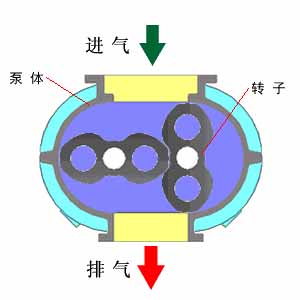
Roots Vacuum Pump Principle :
Roots vacuum pump in the pump chamber, there are two “8” shaped rotors installed vertically on a pair of parallel axles, driven by a pair of gears with transmission ratio of 1 to each other reverse synchronous rotation. There is a certain gap between the rotor and the inner wall of the pump housing, which can realize high speed operation. As Roots pump is a vacuum pump without internal compression, the compression ratio is usually very low, so high and medium vacuum pumps need front-stage pumps. The limit vacuum of Roots pump depends not only on the structure and manufacturing accuracy of the pump itself, but also on the limit vacuum of the front pump. In order to improve the vacuum limit of the pump, Roots pump can be used in series.
The working principle of Roots vacuum pump is similar to Roots blower. Because of the continuous rotation of the rotor, the exhausted gas is sucked into the space between the rotor and the pump shell from the intake port, and then discharged through the exhaust port. Because the space of V0 is completely closed after inhalation, there is no compression and expansion of gas in the pump chamber.
But when the top of the rotor rotates around the edge of the exhaust port and the space of V0 is connected with the exhaust side, because the pressure of the exhaust side is high, some of the gas rushes back into the space of v0, which makes the pressure of the gas suddenly increase. When the rotor continues to rotate, the gas is discharged out of the pump.
Roots Vacuum Pump characteristics :
Quick start-up, low power consumption, low operating protection cost, high pumping speed, high efficiency, insensitive to a large number of water vapor and dust contained in the exhausted gas, large pumping rate in the pressure scale of 100-1 Pa, can quickly eliminate sudden gas release. This pressure scale is just between the oil-sealed mechanical vacuum pump and the decentralized pump. Therefore, it is often connected in series between the distributed pump and the oil-sealed mechanical vacuum pump to improve the pumping capacity of the pressure scale at both ends. At this time it is also called mechanical booster pump.
(1) There is a larger pumping speed in a wider pressure range;
(2) The rotor has good geometric symmetry, so the vibration is small and the operation is bumpy. There are clearances between the rotors and between the rotors and the shells, which do not need to be smooth, and the friction loss is small. The driving power can be greatly reduced, so that the higher speed can be achieved.
(3) There is no need for oil sealing and smoothness in the pump chamber, which can increase the purification of the vacuum system by oil vapor.
(4) There is no contraction and no exhaust valve in the pump chamber. The structure is simple and compact, and insensitive to dust and water vapor in the exhausted gas.
(5) The contraction ratio is low and the consequence of hydrogen pumping is poor.
Roots Vacuum Pump Application:
Roots vacuum pump has been tested by long-term operation in petroleum, chemical industry, plastics, pesticides, steam turbine rotor dynamic balance, aerospace space simulation and other devices, so it should be vigorously promoted and applied in China. At the same time, Roots vacuum pump is widely used in vacuum metallurgy smelting, degassing, rolling, as well as in food, pharmaceutical industry, vacuum distillation, vacuum concentration and vacuum drying. Vacuum pump accessories for noise control of vacuum pump, vacuum pump muffler.
The appearance of the rotor is a complex curved cylinder, which is difficult to process and review. Roots pump has been developed rapidly at home and abroad in recent years. It has been widely used in smelting, petrochemical, electrical and electronic industries.
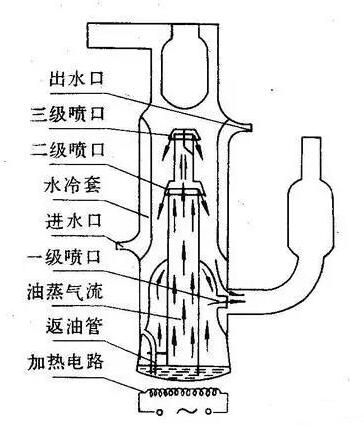
oil diffusion vacuum pump working principle :
Oil diffusion vacuum pump adopts stainless steel inner chamber with longitudinal superimposed conical nozzle inner chamber. Usually there are three nozzle chambers whose size decreases one by one, and the largest one is at the bottom. At the bottom of the chamber is a special low vapor pressure oil. The oil is heated and boiled by an electric heater under the bottom of the inner chamber, and the gasified oil moves upward and is discharged from the injection ports of each inner chamber. Water circulates through the outer wall of the inner chamber to cool the inner chamber, thus avoiding heat spillover and maintaining its long-term operation.
The only reason it’s called a diffuser pump is that the way the molecule from which the gas is extracted seeps into the steam nozzle is similar to the way one gas diffuses into another. Out of a fairly large diameter jet, high-energy oil droplets fall down between the inner chamber and the inner wall at a speed of 750 miles per hour. These droplets have reached supersonic speeds, but there is no sonic boom, mainly because the molecular spacing is too large in some vacuum states to transmit sound energy. The capture rate of a steam nozzle depends on its density, velocity and molecular weight. The collision between a high-speed nozzle and a gas molecule that happens to enter it is due to the thermal motion of the gas molecule. This usually gives the molecules downward momentum so that they can be discharged from the pump exhaust to achieve a higher vacuum level. At the bottom of the chamber, the accumulated atmospheric gas molecules are eliminated by an auxiliary pump, while the accumulated oil begins another cycle.
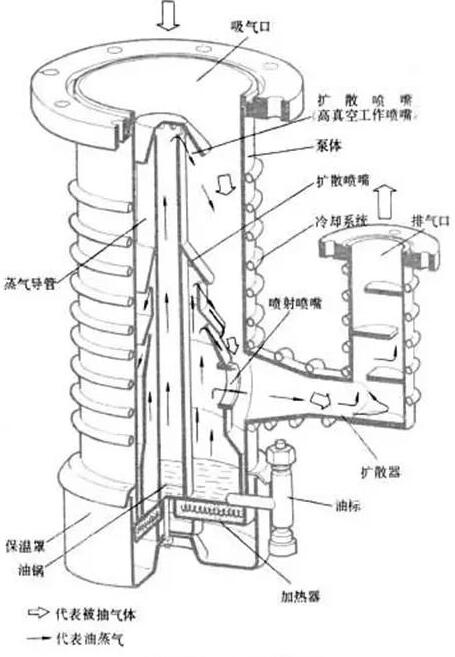
oil diffusion vacuum pump performance parameters:
Usually, the performance of diffusion pump depends on the limit vacuum, maximum back pressure, pumping rate and setting of cold trap or low temperature baffle.
1.Limit vacuum
If the structure of general oil diffusion pump is improved, such as reducing the reflux of oil vapor, adding a pick-up device, rationally distributing heating power, improving the design of nozzle angle, adding oil cap, baffle or cold trap, adsorption trap, etc., the performance of the diffusion pump can be greatly improved, and the ultimate vacuum can achieve lower pressure.
2.Maximum Backpressure
The maximum back pressure is the maximum allowable pre-pressure of the diffusion pump. If the pressure produced by the front pump is higher than the maximum back pressure, the diffusion pump will not work properly.
3.Pumping rate
The pumping speed of diffusion pump can be calculated according to the theory of gas molecule motion.
4.Reasons for setting cold traps and low temperature baffles
Because of the oil vapor molecule ejected from the nozzle of the diffusion pump, most of it is condensed by the pump wall, which is due to the installation of cooling water jacket or cooling pipe outside the pump wall. However, a small number of vapor molecules are reflected by the pump wall, and scattering will return to the pumped space. This phenomenon should be paid special attention in low temperature laboratories. If a cold trap or a low temperature baffle is added before the diffusion pump and the pumped container, the back-added vapor can be condensed and the back-flow of oil vapor can be cut off.
oil diffusion Pump application Range:
The working principle of diffusion pump is similar to that of steam jet pump. Both of them use high-speed steam jet to carry gas in order to achieve the purpose of pumping. Therefore, diffusion pump has similar characteristics with steam jet pump. The main difference is that the diffusion pump works in the high vacuum region, and its working pressure ranges from 10-2 to 10-6 PA. Diffusion pumps are widely used in electronic, chemical, metallurgical, mechanical, petroleum and atomic energy industries.
The factors affecting the performance of oil diffusion pump are as follows.
- Reflux of oil diffusion pump.
- Reverse diffusion of gas molecules.
- The cracking decomposition of diffusion pump oil requires that the working oil of diffusion pump should be within the saturated vapor pressure (about 0.00000001Pa at room temperature). It has good thermal stability and is not easy to be oxidized. High boiling point liquid with high molecular weight, such as silicone oil, is the ideal working oil in diffusion pump.
- Pump cleaning is not clean, pollutants remain in the pump and recycle repeatedly, affecting its vacuum.
Diffusion pump is a kind of secondary pump. It needs mechanical pump. At present, diffusion pump is one of the most widely used and main tools to obtain high vacuum. As the front pump. High vacuum diffusion pump is mainly composed of pump body, cooling cap, nozzle, steam guide pipe, heater and cooler.
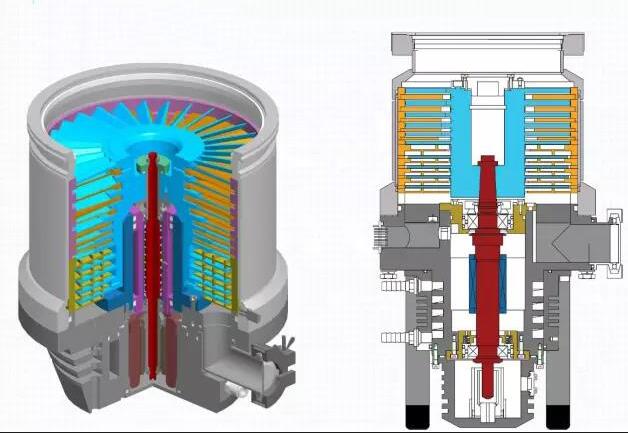
molecular pump working principle :
The pumping mechanism of molecular pump is different from that of mechanical pump which depends on the volume change of pump chamber. The principle of momentum transfer is used to make molecule flow directionally and be discharged from the pump, so as to achieve the purpose of pumping.
Molecular pumps rotate at high speed driven by motors. Frequency conversion power supply is used to drive motors in order to obtain higher speed. In the region of molecular flow, gas molecules collide with the blade surface at high speed, and momentum is transferred to gas molecules, which makes some gas molecules flow in the direction of motion on the rigid body surface and are discharged out of the pump, so as to achieve the purpose of pumping. The phenomenon of carrying gas molecules on the surface of a rigid body at high speed and moving them in a certain direction is usually called molecular traction phenomenon. Vacuum pumps made from this phenomenon are called traction molecular pumps (Gade pumps). The advantages of traction molecular pump are short start-up time, high compression ratio in the molecular flow state, can extract various gases and vapors, especially suitable for extracting heavier gases. However, due to the small pumping speed, too small sealing clearance, poor reliability, easy to mechanical failure, and manufacturing difficulties, it is seldom used in practice. Later, the traction molecular pump was improved, and the turbine molecular pump appeared.
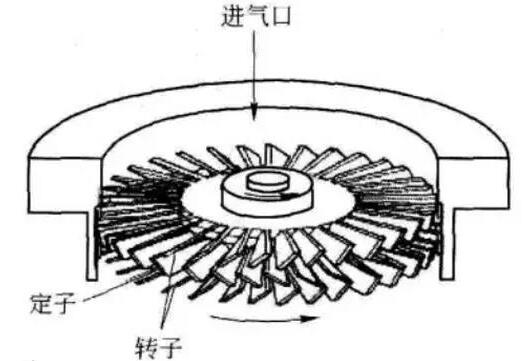
There are many groups of inter-phase moving and fixed blades in turbomolecular pump. Each blade has many oblique blades at a certain angle, as shown in Fig. 1. The actual turbomolecular pumps are composed of multi-stage blades in series, which are arranged alternately according to moving vanes, fixed vanes, moving vanes and so on. When the moving blade rotates, it is similar to the action of the electric fan blade, which can pump gas from one side to the other. Increasing the rotational speed of molecular pump is beneficial to improving the pumping speed of molecular pump. Because of the speed limitation of the blade, if the gas molecule moves faster, it is difficult to pump vacuum.
It can be seen that turbomolecular pump is also a kind of mechanical vacuum pump. By pumping the gas through the combination of high-speed rotating multi-stage turbine rotor blades and static blades, it produces a high compression ratio for the pumped gas in the molecular flow region, so as to obtain the required vacuum performance. The limit vacuum of turbomolecular pump is higher than that of diffusion pump, which can reach 10-8 PA. Normal operation requires a certain degree of vacuum in the front stage. There are slight differences between high and low vacuum pumps. Generally, between 1-200 Pa, mechanical pumps can be used as the front stage pumps. High vacuum units are composed of molecular pumps and mechanical pumps. Because of the high speed of turbomolecular pump, it is usually driven by medium frequency motor. The frequency of medium frequency power supply is between 300 and 400 Hz. Turbomolecular pumps are usually water-cooled.
Compound molecular pump is a series combination of turbomolecular pump and traction molecular pump. It combines the advantages of the two pumps. It has a wide pressure range of 10 ^ – 6 – 1 Pa, a large pumping speed and a high compression ratio, and greatly improves the outlet pressure of the pump.
Molecular Pumps Working Conditions:
(1) The rotor speed reaches 20000r/min, so the starting time of molecular pump is longer.
(2) Gas is in the state of molecular flow, so it needs to be equipped with a front-end pump, which usually uses a rotary vane pump as the front-end pump.
Molecular Pumps Characteristics:
Oil Lubricated Molecular Pump: Small amount of lubricating oil, and in the front vacuum section, less pollution to the vacuum chamber.
Grease Lubricated Molecular Pump: The amount of grease is very small, and the clean vacuum without oil can be obtained by the front graded dry pump.
All-Magnetically Suspended Molecular Pump: Without lubrication, it can be used with dry pump to obtain a clean vacuum environment without oil.
Other common applications:
1.Analysis (Mass Spectrometry, Electron Microscopy, etc.)
2.Semiconductors (electronic components, integrated circuits, flexible solar cells, etc.)
3.Optical/glass (thermal protection, antireflective, reflective, optical filter)
4.Coating (surface protection, decorative paint, display, screen)
5.Vacuum metallurgy (vacuum furnace, vacuum brazing, vacuum sintering, vacuum alloys,)
6.Leak Detection (Vacuum System, Vehicle Fuel Tank, Safety Air Bag)
7.Research experiments (medical magnetic resonance imaging, nuclear particle physics, nuclear fusion research, laser applications and many more)
8.Lamp production industry and related

